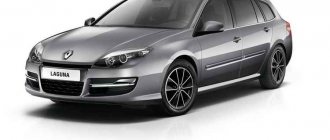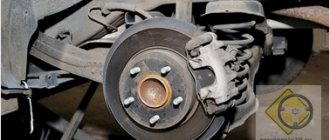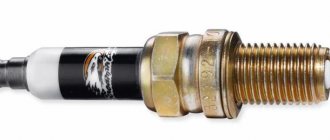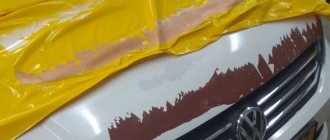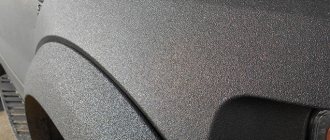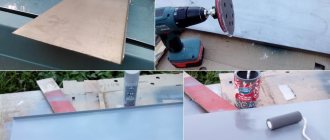Why doesn’t “galvanizing” the body protect modern cars from corrosion?
It seems the world has gone crazy. It seems that automakers have invented a super method that has forever solved the problem of car body corrosion. We are talking about the fashionable zinc body treatment, which is used to coat all new cars today. Naturally, automobile companies in their advertising brochures try to convince consumers that a galvanized body reliably protects the car from rust. As a result, many car enthusiasts (especially the younger generation of people) think that “galvanization” will allow the body to serve for a very, very long time. This also led to the fact that many car owners began to believe that modern cars do not need anticorrosive agents. But it's not that simple.
Yes, of course, zinc coating of the body reliably protects the metal of the body from corrosion. But unfortunately, zinc does not guarantee that rust will not appear on your car for a very long time. Everything, of course, depends on how the galvanization of the body was done, which elements of the car were coated with zinc, what thickness of the zinc layer was applied to the body elements of the vehicle, etc. Naturally, the more thoroughly the body is treated with galvanized coating, the more reliably the car body is protected from rust formation. But unfortunately, not all cars have the same thickness of galvanized coating. This is due to the cost of a particular model. You must understand that an economy class car is not treated with zinc like a premium class model, because otherwise a cheap car would be very expensive.
Unfortunately, no one knows for sure how car manufacturers coat their cars with galvanized coating. These are internal quality standards of the production itself, which is unlikely to be revealed to you by anyone.
Only one thing is known. Today, automakers typically use several types of galvanization of the body of their products:
— Cold galvanizing
— Galvanic galvanization
— Hot galvanizing
The most unreliable galvanizing is cold galvanizing. With this method of galvanizing cars, a special primer layer of the body is used, which contains zinc powder, which in theory protects the body from corrosion. This is the cheapest galvanizing method, which, unfortunately, is used today by many automobile brands that produce inexpensive cars in the economy segment. The disadvantage of this galvanizing is that if chips, scratches, etc. form on the paint layer, which damage the primer layer containing zinc, the body metal remains unprotected, resulting in the formation of rust, that is, real corrosion.
Galvanic galvanizing is more reliable, but is still inferior in its characteristics to protecting the body from hot-dip galvanizing, which, unfortunately, is usually used only on premium segment cars, due to the fact that this is an expensive method of galvanizing the body, which significantly affects the cost of production.
What body parts are galvanized in the car?
Unfortunately, most automakers, for marketing purposes, often tell consumers in advertising that their cars have galvanized bodies. Many consumers begin to believe that the entire body is galvanized. But in fact, in most modern cars, not all body elements are protected by galvanization.
For example, in the modern car market there are new cars in which galvanized protection is available only on some body elements.
For example, most often automakers treat the sills, bottom, arches and wings with zinc, but for some reason they often forget to galvanize the doors, hood, trunk, etc.
Yes, of course there are new cars in which almost the entire body is galvanized. But there are some nuances here too. For example, some body components have a very thin galvanized layer. Let's say that often the fenders, hood, trunk and even the sills have a not very thick galvanized layer, when both the arches and the bottom are covered with a thicker layer of zinc. As a result, it turns out that the car is almost entirely galvanized, but due to the large difference in the galvanized layer, some body parts have a high risk of corrosion compared to those parts that have a large layer of zinc.
Naturally, taking into account our aggressive winter conditions and road reagents that are ready to corrode everything, some body parts may bloom too quickly even in a new car.
Yes, of course, compared to old cars, modern cars can resist rust much better. This became possible thanks to new technologies for painting the body at the factory and, of course, due to new galvanizing methods.
But nevertheless, miracles do not happen, and galvanization cannot change the laws of physics and chemistry. Sooner or later, rust will do its evil work and begin to destroy your car. First of all, in those places where the body is not covered with a galvanized layer, or in those places where the zinc layer is too small. Corrosion may also appear over time in those places where the galvanized layer has been damaged. Especially if your car is cold zinc treated.
Do modern cars need anticorrosive treatment?
Subscribe to our Viber channel and receive only the most important news without advertising!
A car works properly only when all its elements and mechanisms are in working order. Many owners believe that modern cars use the best anti-corrosion treatment during production, so there is no need to worry about the condition of the car.
Indeed, almost all new cars are produced on the basis of a galvanized body. But does this mean that the machine will have enough of this and does not need to process it? Let's figure out whether anticorrosive protection is needed for a modern car.
What kind of anti-corrosion coating is used on new cars? During production, mastic materials are first applied to body parts. Such a coating is indeed effective, but only as long as there is adhesion between the materials. In other words, while the coating is on the metal. At the factory, processing is carried out very quickly and in this short time the material may simply not be distributed to all places. Until the time of sale, the car is subject to factors such as temperature changes and condensation. And this leads to the beginning of the development of corrosion centers. That is why good specialists at dealerships strongly recommend additional anti-corrosion treatment.
Car.ru
Does the car need to be treated? The manufacturer can colorfully describe the production process, but this does not mean that galvanizing is a guarantee that the car will not be susceptible to rust. This warranty covers “through” corrosion only. That is, the driver can be sure that after 5 years there will be no rust in the form of holes on the car. Galvanization provides only electrochemical protection.
Combination of anti-corrosion treatment and sound insulation. Not all car owners know that anti-corrosion treatment can not only protect the body from rust, but also improve sound insulation. After treatment, the car interior becomes almost 2 times quieter.
Anti-corrosion procedures in service. There is no need to immediately run to service specialists and ask them to treat the car. Before doing this, you need to familiarize yourself with what materials the master will use and how long it will take to fully operate the car. Today there are a lot of Chinese drugs on the market, which, as a rule, are not of high quality. Therefore, if you do not find out about the treatment agent in advance, you cannot be sure that the car will not rust in six months.
Brands such as Soudal or Dinitrol are in good demand. The materials perform their functions perfectly even under the influence of temperatures and moisture.
Bottom line. If you are the owner of a modern car, this does not mean that it does not need to be treated with anti-corrosion agents. In order for the results after the procedure to last a long time, it is necessary to choose high-quality materials for processing. Source
Is it necessary to carry out anti-corrosion treatment on the body of a new car?
Applying galvanized primer coat to Nissan Qashqai
This question probably worries all happy owners of new cars without exception. Unfortunately, many car owners believe that doing anticorrosive work on a new car is a waste of money. But in reality this is a mistake. You can’t be so sure of the automaker’s honesty. You don’t even know which body parts are galvanized and what layer of zinc is applied to them.
Yes, all automakers today protect car bodies from corrosion at the factory. But this does not mean that a galvanized car is reliably protected from rust forever. After all, the body of your car contains metal, which, when interacting with oxygen and moisture, will sooner or later begin to rust. And often from the inside.
So galvanizing the body does not completely protect modern cars from rust, although it significantly extends the life of the car compared to old cars, which could completely rot in just a few years.
Therefore, when purchasing a new car, it is still better to carry out a thorough anticorrosive treatment of all body parts that are most susceptible to the aggressive effects of the external environment. In any case, it is better to do anti-corrosion treatment than not to do it. In any case, anticorrosive will not hurt.
But thanks to the anti-corrosion treatment, you will have peace of mind and in case of dishonesty of the car manufacturer, you will be protected from the consequences of body corrosion.
A striking example of this is the recently identified problem with Hyundai Creta crossovers, whose owners began to complain about the appearance of rust on the body of new cars. Moreover, there are known cases where rust appeared after just a few months of owning the car.
Details here.
The best anti-corrosion treatments
The automotive accessories industry produces dozens of anticorrosion agents, which are not easy for the average car owner to understand.
Such materials for anti-corrosion treatment of cars as PRIM, Dinitrol, Tectyl have proven themselves in operation.
A good quality anti-corrosion agent should have:
- resistance to mechanical stress - impacts from road stones, gravel, sand, ice;
- adhesion to automotive enamel;
- water-repellent properties;
- elasticity;
- resistance to “road chemicals”, salt spray;
- noise-absorbing properties.
It is difficult for an ordinary car enthusiast to carry out anti-corrosion treatment on his own. The main difficulties will be dismantling the chassis elements and processing the internal cavities of the body.
To protect your car from rust, contact the professionals at the Marafet detailing center!
Why do some automakers provide a 10-year or more warranty against body corrosion?
Yes, many car companies today provide a factory warranty against through body corrosion, which is valid for 10 years or even more. But this is also a kind of advertising marketing ploy. After all, this guarantee has many pitfalls and limitations. For example, if the car has been in an accident, the factory warranty for body corrosion may be limited or even terminated. Also, the validity of the warranty depends on the operating conditions of the car, how and where the car is washed, etc.
Unfortunately, there are few cases in the world where the owners of a rotten car received some kind of compensation during its first 10 years of ownership. Yes, within the framework of the basic factory warranty (usually 2-3 years), most car owners receive free repairs of parts that have developed corrosion. But as for the longer life of the machine, with a factory warranty everything is much more complicated. The fact is that, as a rule, car companies do not provide a guarantee for external corrosion, which usually appears when the body is damaged.
Therefore, many automakers are not afraid to openly declare a 10-year warranty against through body corrosion. Moreover, according to statistics, most cars that reach 10 years of age have been involved in an accident at least once, or were not operated properly. As a result, it turns out that you should not believe the promises of automobile companies and count on their integrity regarding the quality of zinc body treatment.
Bottom line
Each owner, of course, will decide for himself whether to carry out anti-corrosion treatment on the body of a new car. Our opinion is unequivocal - anti-corrosion protection is still needed for a new car. It is especially worth treating those body parts that are most susceptible to chips, scratches and other damage that can cause rust due to damage to the galvanized layer.
In addition, in the event of damage to the paintwork, every car owner should carry out body repairs as soon as possible to seal the chip from moisture. Otherwise, there is a risk of corrosion at the site of damage to the body. Moreover, this can actually happen with a new car.
Among other things, we advise all car owners of new cars to apply anti-corrosion protection to the body, first of all, in places of factory welding, where most often there is no galvanized layer or the zinc layer is too thin.
We also recommend that you periodically check the underbody of your vehicle for damage. If they are present, it is necessary to eliminate them as soon as possible and carry out additional protection against rust formation, since the bottom of the car is one of the most vulnerable places in vehicles, where rust most often forms.
Of course, you should also not forget about the various mounting holes in the body of a new car, which are also the most susceptible to rust formation. Therefore, during anti-corrosion treatment, specialists should pay maximum attention to these holes.
Don’t forget to be careful when carrying out additional tuning work on the car. For example, when installing fender liners, new foglights, headlights, etc., which affect the integrity of the body. For example, when drilling new holes or installing new screws. The fact is that by affecting the integrity of the body, you actually expose the metal of the body to an aggressive external environment. Therefore, all new technological holes in the body must be carefully treated with protective compounds.
Information publication: Traffic police news, accidents, traffic fines, traffic police, Online traffic rules exam. Technical inspection
Let's sum it up
It is difficult to give specific recommendations when buying a new car. If you are buying a Lexus or Porsche, you will hardly even think about ordering additional anti-corrosion coating. However, for cheaper cars, anti-corrosion has already become a mandatory procedure. Before ordering services, just look at the reviews of the car to understand the timing of the first signs of corrosion. On Lada, the first dots appear on the bottom already in the first year of operation. And Hyundai, for example, drives without any problems for 3-4 years. For Germans this period is up to 7 years, as well as for most Japanese manufacturers.
Do not blindly trust the specialists and salespeople in the salon. It is better to soberly assess the situation and understand whether you need additional anticorrosive. In this case, you will be able to obtain the necessary information on processing the car without any problems. Ukrainian cars ZAZ Chance, ZAZ Lanos and other representatives of the Zaporozhye plant have always had the saddest anticorrosion from the factory. Even if you did an anti-corrosive treatment when purchasing it, you should seriously look at the condition of the “galvanized” body of this car. By the way, galvanizing, even with good quality, protects the body for up to 7-9 years. Then it is still necessary to carry out anti-corrosion treatment. When buying a new car, would you order an additional anticorrosive agent?
Complete processing of a car in our center takes about 7-10 hours, depending on the model and condition of the body, of which most of the time is spent on preparation (rinse, dry the body)
complex processing includes partial disassembly (wheels, fender liners, some facing parts are removed), washing, drying, processing of hidden cavities, bottom, wheel arches
»
paint protection is the application of protective compounds to the body (in our case, Swiss materials Waxoyl 100Plus), forming a fairly strong protective film on the body, about 10-15 microns thick, that effectively resists the effects of road chemicals, reagents, salt, and ultraviolet radiation. Typically this coating is enough for 40-60 washes. The average body processing time is about 3-4 hours.
>



